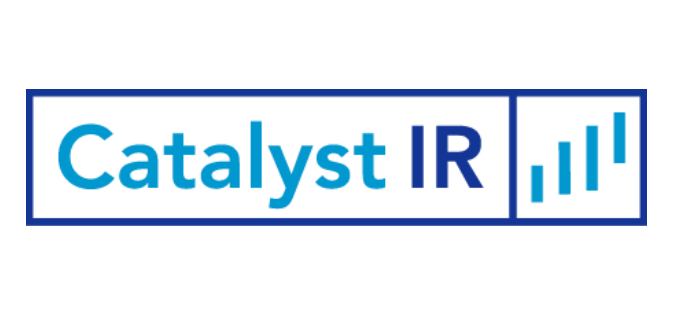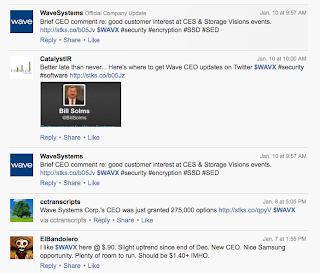Social Media – Leveraging Existing IR Assets to Attract New Eyeballs
In April 2013 the SEC made a bold, progressive step in condoning social media
for Reg. FD compliant disclosure. IR professionals must now figure out how or if to
follow that lead.
follow that lead.
While 70% of IROs report NOT using social media, we believe engagement will
grow as precedent mutes legal concerns and the benefits become better
understood. In our view social media enables more frequent and granular investor
dialogues fostering greater understanding through additional data, anecdotes,
perspective or review. It can also play a key role in crisis communications,
provided the channel is established well in advance.
grow as precedent mutes legal concerns and the benefits become better
understood. In our view social media enables more frequent and granular investor
dialogues fostering greater understanding through additional data, anecdotes,
perspective or review. It can also play a key role in crisis communications,
provided the channel is established well in advance.
But the most compelling argument for IR social media is that it provides an easy
low-cost way to leverage your investment in existing IR assets, putting them
before new investors, bloggers & media with similar interests. It’s no
panacea, but over time builds a growing base of awareness and interest that can
favorably influence your stock price. To be fair, the potential benefits of IR
social media seem more compelling for smaller companies who struggle to develop
investor interest against market currents that favor size and liquidity.
low-cost way to leverage your investment in existing IR assets, putting them
before new investors, bloggers & media with similar interests. It’s no
panacea, but over time builds a growing base of awareness and interest that can
favorably influence your stock price. To be fair, the potential benefits of IR
social media seem more compelling for smaller companies who struggle to develop
investor interest against market currents that favor size and liquidity.
The Myth of Non Engagement
For now, social media’s importance to IR seems a near-sighted measurement of investors
NOT engaged in the medium by similarly positioned IROs. Yet a brief visit to StockTwits,
SeekingAlpha or Twitter confirms existence of a sufficiently large and growing
audience to warrant our attention. Social media has also been validated by hedge
funds who filter it to guide investment decisions, by Bloomberg’s integration
of Twitter feeds into its financial information platform, and lest we forget, @Carl_C_Icahn,
who’s 59 posts to date have drawn enormous Wall Street attention and 123,000
followers.
NOT engaged in the medium by similarly positioned IROs. Yet a brief visit to StockTwits,
SeekingAlpha or Twitter confirms existence of a sufficiently large and growing
audience to warrant our attention. Social media has also been validated by hedge
funds who filter it to guide investment decisions, by Bloomberg’s integration
of Twitter feeds into its financial information platform, and lest we forget, @Carl_C_Icahn,
who’s 59 posts to date have drawn enormous Wall Street attention and 123,000
followers.
The social media dialogue is shaping investor perceptions without you.
And guess what? Your Company is likely the subject of an active social media
dialogue that is shaping investor perceptions without you. Doesn’t it make
sense to balance those communications with approved company messages?
dialogue that is shaping investor perceptions without you. Doesn’t it make
sense to balance those communications with approved company messages?
You’ve got my attention; What would a social media IR program look like?
Because social media is an adjunct to your existing IR communications, the same
disclosure rules and regulations apply. Despite the SEC’s comments, we do not
recommend using social media to initiate material disclosures and our comments reflect
that posture. However, we do recommend following the SEC’s guidance to publicly
state which social media channels you use for investor relations, thereby
protecting your social media efforts.
disclosure rules and regulations apply. Despite the SEC’s comments, we do not
recommend using social media to initiate material disclosures and our comments reflect
that posture. However, we do recommend following the SEC’s guidance to publicly
state which social media channels you use for investor relations, thereby
protecting your social media efforts.
A formal social media program and plan should be developed along with policies
and designated persons for the review and posting of messages and responses.
This policy should be reviewed by management and counsel and updated at least
yearly for any changes in practice, participants or approved social media
forums.
and designated persons for the review and posting of messages and responses.
This policy should be reviewed by management and counsel and updated at least
yearly for any changes in practice, participants or approved social media
forums.
Leading IR social media forums include Twitter, SeekingAlpha, StockTwits, SlideShare,
LinkedIn, Facebook, Boardvote and Stockr. To reflect the unique needs of
investors, public companies should establish standalone IR social media accounts.
The “IR” suffix is frequently used and easily differentiates IR content from
other social media communications (ex. @CompanyIR).
LinkedIn, Facebook, Boardvote and Stockr. To reflect the unique needs of
investors, public companies should establish standalone IR social media accounts.
The “IR” suffix is frequently used and easily differentiates IR content from
other social media communications (ex. @CompanyIR).
We recommend using the same account name across all channels if possible. There is
no cost to set up most accounts, though it does take some time to create a professional
no cost to set up most accounts, though it does take some time to create a professional
profile and presence. Protect account access by using strong passwords and 2-step
authentication. Once set up the posting of approved messages takes just a few minutes
and will become an automatic part of your communications work flow.
But what are we posting? How do we maximize our success?
Social media is a “force multiplier” for the visibility of the IR communications and
collateral you work so hard to create. Most of it has been disclosed on the
wire or via Edgar and is available on your website or those of other organizations,
making it easy to provide direct links. Thus, much of a basic program can
merely involve providing links to IR collateral.
collateral you work so hard to create. Most of it has been disclosed on the
wire or via Edgar and is available on your website or those of other organizations,
making it easy to provide direct links. Thus, much of a basic program can
merely involve providing links to IR collateral.
IR Social media content can include:
· News releases, call transcripts & SEC filings
· Presentation and conference call alerts
· Presentations, webcasts & videos
· Media coverage, interviews, blog posts & social media
· Product brochures, photos & web pages
· Research or other industry or governmental reports or white papers.
· And a range of custom content we’ll save for another article.
Unlike financial portals where content is …. hidden … based on stock
symbols, social media is an unstructured fire hose of information…
rationalized by key words…
Links to this content on their own, however, have little visibility or value (though
we see them all the time) without a clear introduction. Unlike financial
portals where content is safely ordered (and hidden) based on stock symbols,
social media is an unstructured fire hose of information. That data glut is rationalized
by key words or “hash tags” and stock symbols. In addition, “Follower” and
“Followed” functions allow users to filter the torrent down to subjects of
interest.
we see them all the time) without a clear introduction. Unlike financial
portals where content is safely ordered (and hidden) based on stock symbols,
social media is an unstructured fire hose of information. That data glut is rationalized
by key words or “hash tags” and stock symbols. In addition, “Follower” and
“Followed” functions allow users to filter the torrent down to subjects of
interest.
Each post must make clear what content is being referenced and why it is worth
viewing. Assume it is the reader’s first interaction with your Company. Keys to
successful posts include:
viewing. Assume it is the reader’s first interaction with your Company. Keys to
successful posts include:
1) Write clearly and succinctly, to be understandable to anyone. It takes time to
winnow a message into 140 characters. Abbreviations and informal style make
this possible.
winnow a message into 140 characters. Abbreviations and informal style make
this possible.
2) Use appropriate stock symbol nomenclature (generally a $ before the symbol
as in $GOOG) so that all your posts are referenced to your symbol. Credible
use of other relevant stock symbols will also aid your post’s discovery.
as in $GOOG) so that all your posts are referenced to your symbol. Credible
use of other relevant stock symbols will also aid your post’s discovery.
3) Use “hash tags” as they are known on Twitter to reference your post
to topics of interest searched by investors, such as #healthcare, #energy,
#Japan, #timber & #retail. Use the most popular hash tags but also
experiment to reach a different audience. Hash tags position you for discovery by
those who DO NOT know your company or stock symbol.
This is our primary reason for IR social media engagement.
to topics of interest searched by investors, such as #healthcare, #energy,
#Japan, #timber & #retail. Use the most popular hash tags but also
experiment to reach a different audience. Hash tags position you for discovery by
those who DO NOT know your company or stock symbol.
This is our primary reason for IR social media engagement.
4) Link your accounts so that a post to one will automatically syndicate to others.
But read the fine print to optimize your visibility by originating posts on certain sites
and syndicating them to others. Be careful, some sites let you delete posts;
others do not.
But read the fine print to optimize your visibility by originating posts on certain sites
and syndicating them to others. Be careful, some sites let you delete posts;
others do not.
5) Twitter averages 500M tweets per day across all topics, so even after a few days,
a search might not yield your post. To unbury your post, delete and repost it (our
recommendation), alter or add a photo or video and repost, Retweet, comment or
favorite it.
a search might not yield your post. To unbury your post, delete and repost it (our
recommendation), alter or add a photo or video and repost, Retweet, comment or
favorite it.
Below are examples of social media posts on StockTwits. The top set of posts shows
normal text posts and the following three examples show how the posts cut through
the clutter better with the use of a graphic (photo, chart, etc.).
normal text posts and the following three examples show how the posts cut through
the clutter better with the use of a graphic (photo, chart, etc.).
Showing our client’s lithium replacement
battery aboard an electric fork lift.
Showing our client’s diagnostic device in action.
Highlighting our client’s CEO and his Twitter page.
We hope these comments have taken some of the mystery out of
social media for IR – and how it can be easily implemented – and
provided some valid reasons to reconsider your reluctance to enter
the fray.
social media for IR – and how it can be easily implemented – and
provided some valid reasons to reconsider your reluctance to enter
the fray.
David C. Collins
Managing Director
Catalyst IR – Capital Markets Counsel
January 13, 2014




